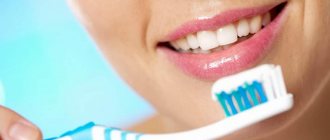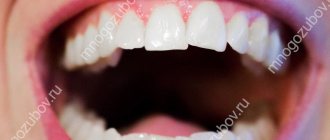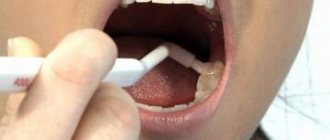Find out more
The need to maintain hygiene
More than 15 thousand bacteria and microbes live in the mouth. By feeding on food particles, they secrete acids that corrode tooth enamel. If you do not follow a set of hygienic measures, a carious cavity will form.
Oral hygiene includes disinfecting measures aimed at removing dental plaque. Maintaining these steps is an important step in preventing dental disease.
By following the rules of cleanliness you can achieve:
- fresh breath;
- healthy enamel color;
- destruction of pathogenic microflora;
- high quality teeth;
- prevention of caries, gum disease and periodontal disease.
Every person needs increased oral care, especially smokers and people with weak immune systems.
How to choose dental floss
Dental floss is another helpful tool if you need to brush your teeth after eating. Instead of using toothpicks found in all cafes and restaurants after lunch or dinner, it is better to use dental floss. A toothpick, due to its shape (a fairly thick base and a sharp tip), is not able to clean the crevices between the teeth, but at the same time it injures the gums. Dental floss is very thin, which allows it to penetrate between the teeth without contacting the gums. Let's figure out how to choose the right dental floss.
Dental floss varies in thickness and composition. In terms of thickness, choose thicker threads if you have large distances between your teeth and thin ones if there is crowding or your teeth are very tightly spaced. The thickness of the thread is always indicated on the packaging. Use waxed floss; it moves easier between your teeth and even makes a distinctive sound when your teeth are cleaned. If you wear braces, unwaxed floss is contraindicated because it will simply get tangled in the brackets.
Some manufacturers offer flavored dental floss, but mint or other flavors do not affect the quality of the floss in any way, so it is called a matter of taste. You can also choose dental floss fixed between two plastic holders. This option will make brushing your teeth easier and free up your other hand.
The main purpose of dental floss is to clean teeth in hard-to-reach places, thus preventing the accumulation of bacteria, the formation of plaque and tartar. Naturally, we do not have the opportunity to always take a toothbrush with us to carry out oral hygiene after every meal. This is not required - brushing your teeth with a brush and toothpaste twice a day is enough. But you need to get rid of food deposits on time. This is why it is recommended to carry dental floss with you. And now you know how to choose dental floss.
Types of hygiene
Measures to maintain the microflora of the oral cavity are divided into 2 types:
- Personal hygiene.
This is the basis for maintaining healthy teeth, preventing gum inflammation, caries and enamel destruction. High-quality and effective personal hygiene is not only about brushing your teeth. And it is advisable to know the basic measures to maintain “order” in the mouth from childhood.
- Professional cleaning.
It is performed by a dentist in a medical office.
It is important to note that these points do not exclude, but complement each other. It is necessary to undergo a preventive examination (2 times a year), observe the rules of personal hygiene and periodically resort to deep cleaning. All this will help prevent oral diseases and maintain the attractiveness of your smile.
How to brush your child's teeth?
Children's toothpaste is not just toothpaste in bright children's packaging, as some parents think. The paste becomes “childish” primarily due to its special composition . The pleasant taste also plays a role, making the process of brushing teeth more attractive (show us a child who will be happy to brush his teeth the first time?).
Like toothpastes for adults, children's toothpastes should clean teeth well, but do it carefully, without damaging the enamel. For this purpose, they contain very soft abrasive particles .
It is important that the paste has a preventive effect , which is achieved by introducing fluorine, phosphorus and calcium compounds into its . These elements are able to integrate into the crystal lattice of tooth enamel and strengthen it. Among them, fluorine is the most important element. Please note: the amount of fluoride clearly “tied” to the age of the child , and the “age of use” is always clearly marked on the paste tubes.
Pastes for children “up to 6 years old” or “4-7 years old” contain the minimum percentage of fluorides (according to GOST - 500 ppmF).
Pastes for children “from 6 years old” (or “6+”) or “from 8 to 18”, “for schoolchildren”, etc. — the amount of fluorine almost triples (up to 1500 ppmF). rule : the older children become, the more noticeable the amount of fluorides in toothpastes produced for them approaches “adult levels.”
Parents of children with allergies should look for a hypoallergenic toothpaste that does not contain artificial colors, preservatives or fragrances. Too bright, unnatural color and a very strong aroma of the paste should alert the mother, especially if she chooses the paste “for the first time.”
Feature of carrying out independent hygiene procedures
A full range of hygiene procedures includes:
- Using a toothbrush.
They are traditional (manual), electric and ultrasonic. It is believed that an electric brush is more effective in combating deposits and removing plaque. Many people are concerned about the issue of gum trauma. However, if the replacement head fits tightly on the brush and there are no chips on its body, it will not cause harm to your teeth and gums. In any case, in order for the cleaning process with any type of brush to be of high quality, it is important to devote at least 2-3 minutes to it.
- Using toothpaste.
Rospotrebnadzor identifies 4 types of the most effective pastes:
- Fluorine-containing. Reduces the risk of developing caries and demineralization of enamel.
- Whitening;
- Desensitizing. Reduces tooth sensitivity;
- With triclosan. They have an anti-inflammatory effect. It is desirable that the paste does not contain sodium lauryl sulfate, sodium cocosulfate, fluorine, or titanium dioxide.
- Using brushes and dental floss.
They remove food debris stuck in the interdental space.
- Use of rinses.
Essentially, these are antiseptic solutions that reduce the number of microbes in the mouth and also eliminate unpleasant odors.
- Using an irrigator.
This is a device that uses water to help clean teeth from food debris. The percentage of oral cavity cleansing is 99%. An irrigator is an intermediate step between home and professional cleaning. But if you want to spend as little money as possible on a dentist and enjoy your dental health as much as possible, then you can’t do without it.
Oral hygiene products
Toothbrush
The simplest and most well-known hygiene product, which is used to remove food particles and remove plaque formed on teeth.
Toothbrushes vary in shape, type of bristles and hardness, which are selected taking into account the condition of the teeth and gums.
Dental floss
Used to remove food from the interdental space. Dental floss varies in the number of fibers and cross-sectional shape. These products must be used carefully so as not to accidentally damage the gums at the roots of the teeth.
Toothpaste/gel
The product is used for hygienic treatment, prevention or treatment of various diseases of the oral cavity.
Toothpaste or gel is selected individually depending on the condition of the teeth and gums and the desired effect (elimination of unpleasant odor, reduction of tooth sensitivity, whitening, etc.).
Professional cleaning
Since it is impossible to provide proper protection of the oral cavity from caries and other more serious diseases at home, dentists insist on visiting professional cleaning at least twice a year. The main advantages of this procedure:
- reduction of pathogenic microflora;
- increasing local immunity;
- removal of dental plaque.
Professional cleaning includes several stages:
- Removing soft plaque using the Air Flow air-abrasive technique. The device precisely delivers a powerful water-air jet, saturated with small abrasive particles, onto the tooth surface. Thanks to this, the area of the periodontal canals is cleared of pigmented plaque.
- Ultrasonic cleaning. Has antibacterial and antimicrobial effects. Thanks to thin attachments, the ultrasonic method helps remove stone from the supragingival part of the tooth, from under the gum and from the gingival canals.
- Polishing enamel with special pastes. To prevent plaque from sticking to the teeth, their surface should be as smooth as possible. Phyto-extracts have a mild whitening effect and also help strengthen the enamel.
- Strengthening fluoride therapy. This stage is not mandatory, but is carried out at the request of the patient. Disposable mouth guards are filled with a special remineralizing gel and placed on the upper and lower jaw. The gel lasts until it forms a thin protective film and is then washed off with water.
“Even with high-quality personal hygiene (and not everyone can boast of it) and cleansing of soft plaque, hard plaque (tartar) forms. This is due to both food debris and the mineral composition of saliva. Dental plaque contains a huge number of bacteria that cause and maintain inflammation in the periodontal tissues (tissues surrounding the tooth). Constantly inflamed gums cause bad breath, bleeding, and the saddest consequence is the destruction (loss) of bone tissue around the tooth. This disease is called periodontitis or periodontal disease, and it is what leads to tooth loss. With age, the rate of formation of hard plaque increases, and the risk of remaining without teeth increases. Regular professional hygiene allows you to promptly remove hard plaque and, therefore, protects teeth from falling out.”
Sergey Andreev
Candidate of Medical Sciences, dentist-therapist, orthopedic dentist, pediatric dentist
Teething
It is often difficult for parents to determine whether their baby is cutting a tooth or whether his reaction is caused by other reasons. Teething may be indicated by excessive salivation, redness of the gums, irritation of the skin around the mouth, diarrhea, and frequent awakenings at night. If your baby happily allows you to put your finger in his mouth and massage his gums, but does not allow you to look into his mouth, this is one of the signs of teething. In some children, teeth erupt evenly from month to month, while in others, sharp bursts are interspersed with pauses. Sometimes in a week 4 tubercles appear at once, indicating the imminent appearance of new teeth; in this case, you will have a particularly troublesome time.
The teething process can be disturbing and irritating for your baby. When temporary chewing teeth are cut, some babies experience very severe pain and their gums become swollen. You can relieve your baby's discomfort by using a cold compress in the shape of a dental arch. Breaking teeth make the baby want to chew on something or someone. He needs something hard to scratch his irritated gums on. During this period, teeth marks may appear on the railings of the crib, and the baby may bite and squeeze your finger and even your breast with his gums during feeding. Give your baby something cold and hard to chew on - this could be a refrigerated cookie or a special chew ring.
As for food, the situation here is different. For some children, teething does not affect their nutrition in any way, some require more food, but there are also children who refuse to eat during the teething period. The most important thing is not to panic, the baby will not remain hungry: as soon as the pain goes away, the child will make up for lost time. Try to ease your baby's suffering by using a cold spoon to feed.
Be sure to buy special “teethers” at the pharmacy (preferably with pimples and a special gel inside). Before giving them to your child, you can put them in the refrigerator for 20 minutes - the effect will be better. If a child has a high fever and it is clear that he is in pain, give him an antipyretic, but always paracetamol-based. When teething, it is also recommended to lubricate the gums with special gels. One of the most famous is “Kalgel”, although its effect lasts for a maximum of half an hour. "Solcoseryl" is more effective in this sense. However, these drugs should not be used too often: a maximum of 6 times a day, with breaks of at least 3 hours.
During the period of teething, the child especially needs special care for the oral mucosa. Biologically active components from toothpastes should help relieve inflammation and the accompanying pain symptom. They cannot be found in regular toothpastes, so the optimal choice during this period is ROX toothpastes. In particular, toothpaste “ROKS baby aroma of linden from 0 to 3 years”: in addition to the fact that it does not contain fluoride, fragrances and sodium lauryl sulfate and is safe for the child’s body when swallowed, it includes high concentrations of xylitol, which has a pronounced anti-caries effect. In addition, the paste contains linden extract, which has a mild anti-inflammatory effect, necessary for teething.
Oral Care Tips
We have collected the top 5 tips from dentists that must be followed to keep your teeth beautiful and healthy.
- Don't go to bed with unclean teeth. Otherwise, the microbes will secrete lactic acid, which causes caries.
- Learn proper teeth brushing techniques. For example, clean them with smooth circular movements without strong pressure, hold the brush at an angle of 45 degrees, treat not only the outer, but also the inner and chewing surfaces of the teeth.
- Clean your tongue at the end of each brushing of your teeth, as plaque, consisting of dead mucous cells, food particles and microorganisms, is regularly deposited on it.
- Eat more fruits and vegetables. Plant foods contain dietary fiber that helps remove plaque from your teeth and tongue. In addition, fruits are excellent sources of vitamins to maintain oral health.
- Limit your consumption of starchy and sweet foods. The fast carbohydrates they contain stimulate the growth of cariogenic bacteria.
What do we know about baby teeth?
The first milk teeth appear in children from 5 to 8 months . The final growth of baby teeth occurs around the age of three , and the replacement of baby teeth with molars begins at the age of six . The process of changing baby teeth is quite long and can last up to 14 years .
Milk teeth differ from molars , primarily by the lower part of the tooth, hidden by the gum. Baby teeth lack a long root that holds the molar in the gum. Baby teeth are smaller in size than molars. A slight curvature of baby teeth should not cause concern - the position of the teeth can change as the child grows up.
Baby teeth are formed long before birth in the mother's womb . The child takes the substances necessary for this (primarily calcium) from the mother’s body. That is why pregnant women are recommended to take vitamins specially designed for them. If there is a lack of calcium in the mother’s body, her own teeth are in danger of trouble.
What happens if you don't maintain hygiene?
If you neglect the process of oral hygiene care, it can ultimately lead to many unpleasant consequences. Among them:
- Caries;
- Gingivitis (gum inflammation);
- Candidiasis (infection caused by bacteria of the genus Candida. Manifests itself in the form of a yellowish and grayish coating);
- Periodontitis. This is an inflammatory disease of the gums, characterized by tissue atrophy;
- Stomatitis (inflammation of the oral mucosa).
Free webinars on anti-aging medicine Learn about the features of the Anti-Age Expert International School, as well as the opportunities for improving your medical practice every day. The webinar program also includes fascinating reviews of innovations in anti-aging medicine and analyzes of the most complex clinical cases with recommendations that really work
Find out more
How are the first teeth cut?
Teaching your child the rules of personal hygiene
Children are taught hygiene procedures from the first days of life. Find out how to teach your child to practice personal hygiene on his own.
The main symptoms of teething in infants are increased salivation and swelling of the gums.
The process is usually uncomfortable for the child and may be accompanied by increased moodiness and crying for no reason, insomnia and loss of appetite. A slight increase in temperature
(up to 38°C) may be a natural protective reaction of the body, but in this case the child should be shown to a doctor.
You can help the baby a little. Buy several teethers
- rubber or plastic toys for the child to bite on.
Chewing rings with liquid inside, which are first placed in the refrigerator to cool, has a particularly soothing effect. Additional methods
: Gently massage the baby's gums with a gauze pad soaked in cold water, or use baby teething gels with anesthetics, which the pediatrician will recommend.
When teeth come through
The time for the appearance of the first tooth varies for each child - on average, at 6-8 months. A one-year-old baby already has 8 teeth, and by the age of one and a half years there will be 12–16. The complete set of chewing teeth, canines and incisors ends by the age of three.
Caring for a child’s teeth should begin from the first days of a baby’s life. However, tooth formation begins in utero, at the 20th week of pregnancy. It is important that the mother’s diet includes plant and animal proteins every day - eggs, dairy products, meat, fish, as well as fruits and vegetables.











